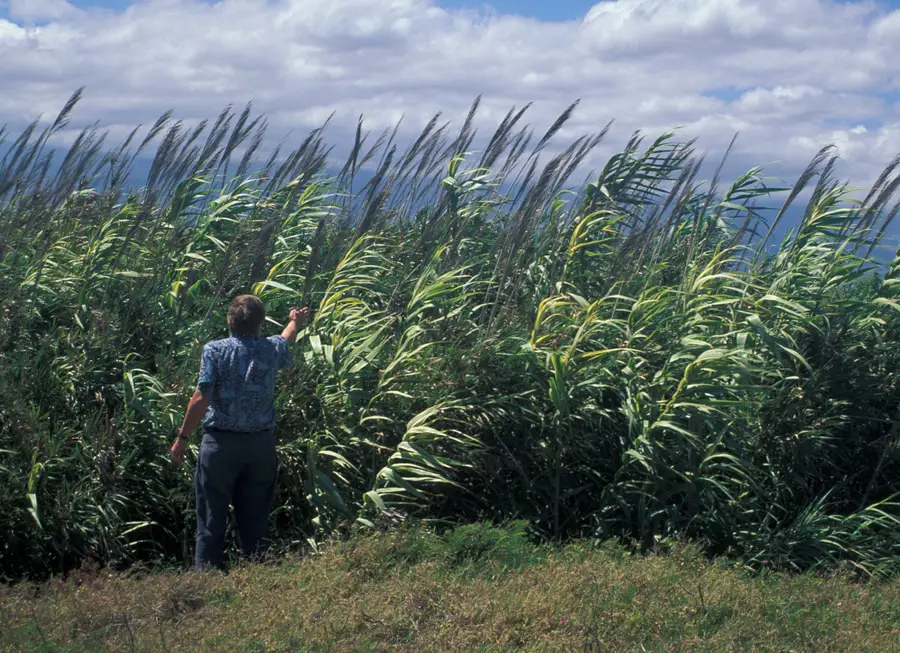Don’t be fooled by imitations. While there are several hundred (if not thousands) of species of bamboo, there are also a handful of lookalikes to be aware of, and perhaps avoided. Previously, we told you about that friendly desktop pot of Lucky Bamboo that you probably thought belonged to the bamboo family. Don’t worry, we forgive you. It was an honest mistake. The folks at the hardware store just wouldn’t sell as many if they labeled them “Lucky Dracaena”.
Today we’d like to tell you about an invasive reed grass clogging the creek beds of southern California and other warm regions of the country, and spreading vigorously. From a distance, and to the untrained eye, it looks a lot like bamboo. But it’s actually a Mediterranean import known as Arundo donax or giant cane. Although it’s sometimes even referred to mistakenly as Arundo bamboo.
Arundo donax, commonly known as cane grass, giant cane or giant reed, is a tall species of reed grass native to the Middle East and widespread throughout the Mediterranean. Canes grow about 10-20 feet high and resemble bamboo. But the stems are softer, less woody than bamboo, and the plants will die back in the winter, unlike most bamboo species. Like all species of bamboo, A. donax belongs to the grass family, Poaceae.
What is Arundo donax and why is it a problem?
- Aggressive growth habit: As you probably realize, or perhaps have even witnessed, many varieties of bamboo can also be very invasive. What starts as an ornamental accent or an oriental privacy hedge can spread into a horrible nuisance under the right (or wrong) conditions. This is what we call “sustainability in its unfriendliest form.” While it makes a beautiful addition to many domestic landscapes, bamboo does require proper containment. This can be as cheap and simple as an old wine barrel, or as expensive and complicated as you want to make it. Otherwise, it will spread and spread, generally in the direction of water, such as lawn sprinklers.
- Invasive species: Unlike bamboo, Arundo donax is native to the Mediterranean. This means that California climate conditions are ideal, with or without the irrigation required by most species of bamboo. It was brought over in the 1820s for erosion control in the Los Angeles area, and in the subsequent 200 years has established a tenacious foothold throughout the region, but especially in riverbeds.
- Predator resistance: As with most invasive, non-native species, Giant Cane has no real predators or competitors in this part of the world, so it continues to spread unchecked while choking out the native flora. Ideas for containment range from toxic chemical herbicides (not necessarily something we like to see sprayed around creeks and river beds) to the importation of natural predator insects from the other side of the globe (can you say “unanticipated environmental consequences”?).
- Toxicity: One reason that the Arundo donax is so resilient against local insects has to do with the high levels of noxious chemicals in its leaves and stems. As so often happens in plant chemistry, many of these “toxic” chemicals also happen to be psychotropic alkaloids and tryptamine compounds. So while it may lack most of the industrial applications that bamboo is known for, this giant reed grass may have certain pharmaceutical and/or recreational uses yet to be fully explored.
- Elegance and durability: The Giant Cane has historically been used for flute making and is also said to be an ideal material to make reeds for woodwind instruments. But the canes are not nearly as hard and durable as bamboo, although it does get very tall (upwards of 20 feet) with fairly thick canes (over 1″ in diameter). But despite its size and feasibility as a privacy screen, Arundo donax does not have nearly the same grace and elegance as a healthy stand of bamboo.
- Fire hazard: Highly flammable, the cane grass has been known to increase the probability and intensity of wildfires. And what’s worse, it has a far better burn-recovery rate than any native species, so that when the landscape is decimated by fire, the canes sprout up first, leaving no room for the original natives to return or survive. Along with the factors listed above, these characteristics make the Giant Cane’s invasive potential far worse than that of bamboo.
Potential benefits of Arundo donax?
We’ve spelled out a litany of threats and detriments posed by this giant reed grass, but surely it must have some positive attributes? Yes, in fact, with increasing concern over climate change and greenhouse gasses, Arundo donax has been identified as having a relatively high capacity for converting carbon dioxide into oxygen (somewhat similar to bamboo) and for sequestering carbon in the soil. For this reason, it is sometimes planted as a cover crop and rotated between cereals and grains.
Also, on account of its carbon sequestration and its tenacious growth habit, giant cane grass is now recognized as one of the most promising crops for bio-fuel and energy production in Europe. Several energy companies are currently working with Arundo donax and studying its potential more closely.
In the meantime, unless you’re planting a cover crop or using your backyard to produce bio-fuel, we encourage you to avoid Arundo donax and plant some more attractive varieties of bamboo instead. But be careful, these grasses tend to spread aggressively, and if you don’t take proper precautions, you too could find yourself on the wrong end of a sustainable revolution. (See our in-depth article on Running Bamboo vs. Clumping Bamboo.)

Cane grass and sax appeal
Something else I learned more recently is that Arundo donax is the traditional source of clarinet and saxophone reeds. Why do you think they call them reeds? A. donax is a giant reed grass. Softer than bamboo, but still woody, the fibers of the exotic grass are uniquely suited to produce the ideal vibrations for a woodwind instrument. Plantations in Europe and South America (both the northern and southern hemispheres) ensure a year-round supply of musical reeds, as the annual plant has to be harvested in the winter when the fiber quality is at its peak.
Where Arundo donax comes from
Giant reed grass grows invasively throughout much of the southern United States. Many confuse it with bamboo, but most plant lovers know the difference, and also recognize it to be non-native.
In Europe, it’s also common to find this plant proliferating around the Mediterranean regions. It’s grown there so long that many consider it to be native. And although it may be naturalized, it actually originated at the other end of the sea, in the Middle East.
Wherever it grows, people continue to confuse it with its distant but favorable cousin, bamboo. Bamboo has much woodier stems and is far more durable for craft-making and light construction. Most species of bamboo will also survive the freezing winters without dying back or turning brown, which Arundo donax cannot.
NOTE: This article originally appeared in May 2010, updated in April 2022.
Keep on the grass
If you’re into plants and botanical taxonomy and want to learn more about the classification of bamboo, check out some of these curious excursions.
- Plants that look like bamboo (but aren’t)
- Introducing bamboo: Genus by genus
- Bamboo tribes
- Exotic bamboo varieties
FEATURE IMAGE: Wikipedia










I always enjoy my grasses. Responsibly.
Saw three massive clumps of arundo donax recently while searching for some property in Winfield Kansas
South east of Wichita
20 miles north of Kansas Oklahoma border
Even cold temps are not a way to kill this plant
I see a lot of this of course scattered throughout the south
Not just California
Did it out
Burn what you removed
Come back next year and get what you missed
Seems to be what works
That’s my two cents
Keep giving us this great info
It is appreciated
Thanks
A.Donax was also used in Malta to manufacture the curtains in front of doors and windows. This would allow the air flow during the summer, as you can keep the door open behind the screen.
Regrettably, most screens are now imported from overseas, as they are cheaper than locally, hand-made products.